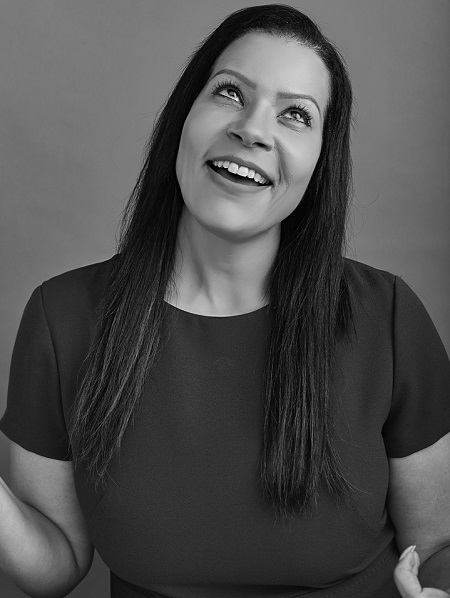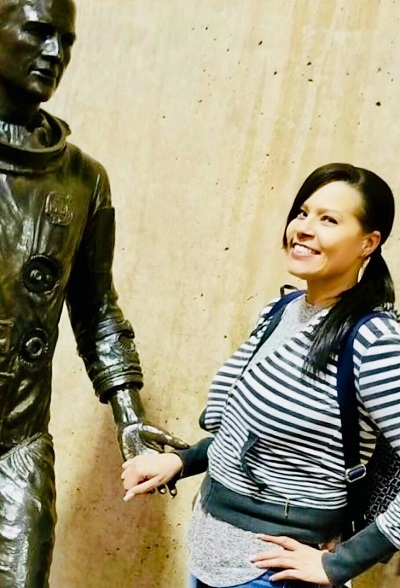
A self-confessed “lifelong learner,” when Xiomara Romine earned her doctoral degree in education, she felt like she’d hit a glass ceiling. She’d imagined a long career in education leadership, with the end goal of becoming a school principal, leading a school district, or teaching college classes.
However, she had always been an artist–over the years, she freelanced as an artist and graphic designer producing posters, CD sleeves, booklets, menus, and advertising media for various clients–and she missed exercising her creative side.
Five years ago, she enrolled in a short-term coding bootcamp just so she could learn how to code for fun. During the bootcamp, she was assigned a mentor, and they had a conversation that would change the course of her career.
“After talking to him for about 20 minutes about my skills and career goals, he looked at me and said, ‘You should be a UX designer,’” Xiomara recalls. “At the time, I’d never heard of UX design. But then I did a little research and it got stuck in the back of my mind.”
After completing the UI/UX Design Career Track, Xiomara’s mentor at Springboard offered her a design role at a London-based consulting firm called FutureSight, where he was the director of design. Xiomara now works full-time as UX/UI designer and her former mentor is now her boss.
I was in the education and design field for a long time. I taught fine art for 11 years, then graphic design. I obtained my educational leadership degrees and finally my doctorate. I worked in education leadership for about five years, which I really enjoyed, but I missed design. I had moved away from that and was doing a lot of analytical and researched-based data analytics work.
I didn't think I would totally switch careers at this stage of my life, but I found myself thinking back to how much I enjoyed doing design and artistic endeavors. I also wanted to use my knowledge in research, education, and data analysis, so I started thinking, how can I combine the two? That’s how I decided to study UX/UI design.
I work at a design studio called FutureSight. We are redesigning a customer portal for a client, and I’m the sole UI/UX designer on the project. This portal lets customers register their products or request repairs or other services. The challenge is unique because this hub not only serves the customer, but there’s a backend that serves partners, resellers, and customer service staff, so we have to design for three different users. It’s challenging but super exciting and fun. I just got back from our first team summit in Sweden, so it’s been a whirlwind.

When I first onboarded, I got a little overwhelmed when I saw how intricate the system was and how many different users there would be. People were really disappointed in the current system, so it seemed like a lot of pressure. At the team summit in Sweden, I had to give a presentation on user personas in front of a large audience. They were expecting me to get it right, because I had analyzed the data, done the interviews, and gotten to know my users. When I wrapped up, a lot of people asked me for a copy of my presentation. They told me I had nailed the user research, so I’m really excited to find a solution that will benefit them.
I wasn’t hesitant. I’m a researcher, so I created a spreadsheet and compared different programs before deciding on Springboard. Springboard had a lot of great reviews, but what made me choose it was the one-on-one mentorship, plus the on-demand mentorship you could request outside of your weekly mentor calls. Springboard seemed to offer a lot of built-in support, and once I went through the program, I saw that was correct.
I always had so many avenues to get my questions answered. I felt supported in so many areas and I always felt like I was learning what I needed to learn at the right time. I can't speak highly enough about Springboard, I think it was a great program that truly prepared me. I was very confident when I got to the end of the program and started my job search. I felt confident that Springboard was going to continue to be there for me as I searched for a job, so I just think it's a great program.

My mentor was Rafael Jankos [design director at FutureSight.] He’s really good at listening and then helping you with whatever you specifically need. Since I already had a design background, I was pretty strong in a lot of the UI skills.
He saw my strengths and encouraged me to think outside the box. Sometimes I worried that I was doing things wrong because my work didn't look like the other students’ work. He was very supportive and he told me, “That’s a good thing. You have your own style and that’s wonderful. He instilled confidence in me and he gave me lots of tools and resources.
It was a balance between the curriculum and having a mentor who could help me learn how to use the curriculum to the best of my ability. Those two things combined led to my success. I came out with a very strong portfolio of projects and skills.
I didn’t even do a formal job interview with the client I work with now. I was pitching to them and they asked if I could show them a project I had done, so I shared my screen, brought up my portfolio, and showed them a project I’d done through Springboard. Five days later, they reached out to my boss, and said they wanted me working full-time on their project..
I did my IDP with FutureSight, my now-employer. Rafael, my mentor at Springboard and my now-boss, let be the lead UX designer. The client was an online casting studio based in Poland, and they wanted to redesign their website. I got to practice all my skills. I created user flows, wireframes, a style guide, and UI elements. They are still a client of FutureSight, where I work now, so I checked in with them not too long ago and I found that a lot of the things I created during my IDP are still in use.
A lot of Springboard students have reached out to me asking for advice on the job search. I always tell them to make lots of connections–connect with other students, listen to your coaches, take advantage of what your mentor tells you.
I also attended UX meetups. Often, at the end of the presentation, the speaker would say, “By the way, my company is hiring.” Do your best on your projects and share your portfolio widely. I constantly shared mine with friends and family members.
Share what you’ve accomplished and your passion for UX,and you never know where it’ll lead you.









